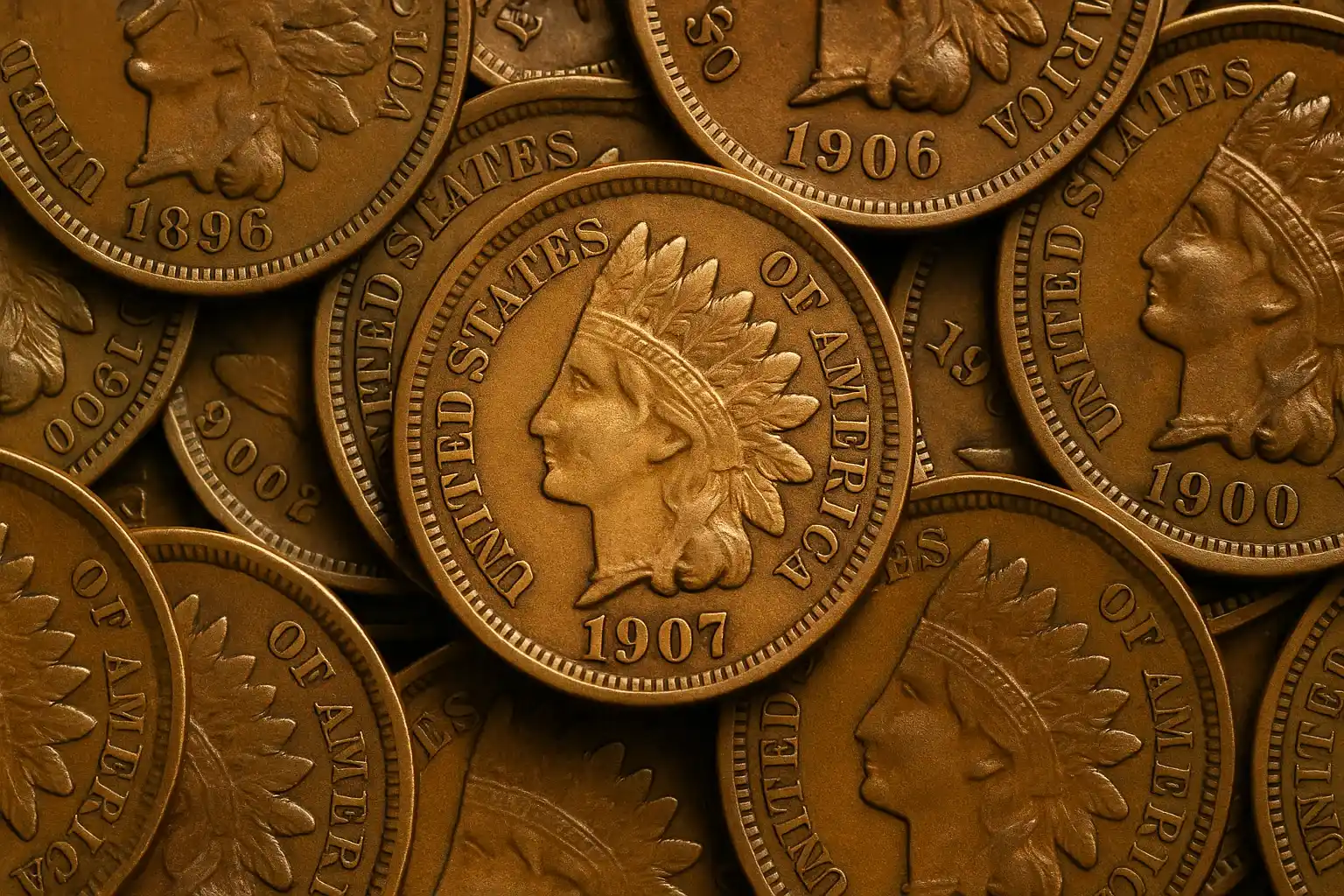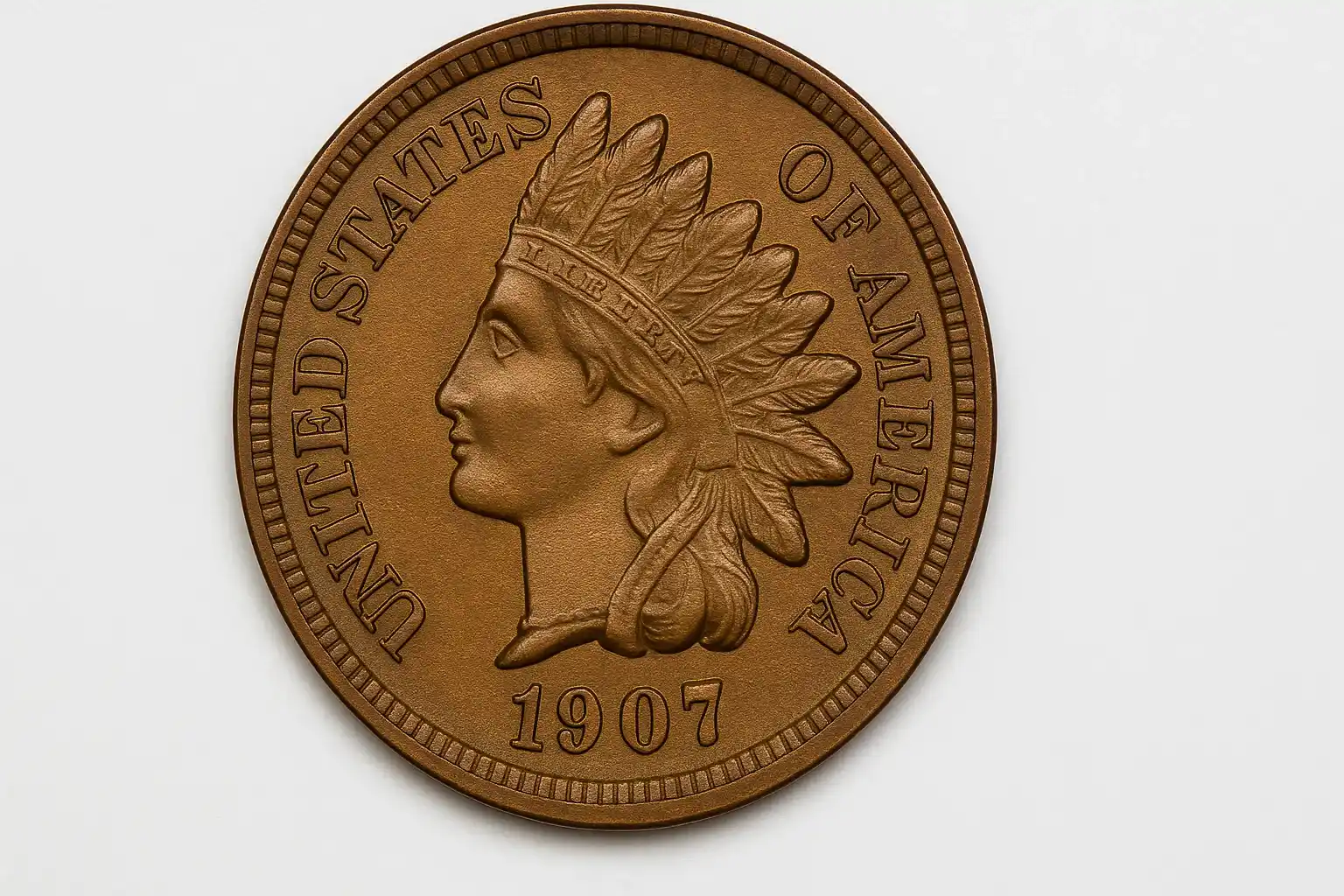The 1907 Indian Head penny is a U.S. one-cent coin struck at the Philadelphia Mint, part of the long-running Indian Head cent series (1859–1909).
Designer: James Barton Longacre (Chief Engraver of the U.S. Mint)
Obverse (front): Liberty wearing a Native American headdress with the word LIBERTY across the band. Around the rim: UNITED STATES OF AMERICA and the date 1907.
Reverse (back): A laurel wreath encircling the denomination ONE CENT. A small shield rests above the wreath.
Composition: 95% copper, 5% tin and zinc (bronze).
Weight: 3.11 grams
Diameter: 19 mm
Edge: Plain
Mintage: About 108.1 million, one of the highest of the series.

Value Overview
Because so many were minted, the 1907 is one of the more common Indian Head cents. Its value depends heavily on condition:
Worn examples (Good–Fine): $2 – $5
Higher grades (XF–AU): $15 – $50
Uncirculated (MS60+): $60 – $200+
Top condition (MS65+ Red): Can reach several hundred dollars.
Collectability
The 1907 cent is popular with collectors because it’s affordable in lower grades, yet high-grade red (full copper luster) examples are scarcer and valuable. It’s also significant as one of the final years before the Indian Head design was replaced by the Lincoln Wheat cent in 1909.
Varieties
The 1907 Indian Head penny is from the Philadelphia Mint only, so it has no mint mark. (The first Indian Head cents with mint marks came later in 1908, when the San Francisco Mint began producing small quantities marked “S.”)
Even though there are no mint mark varieties for 1907, collectors watch closely for error coins and die varieties that increase value.
Common 1907 Errors and Varieties
1. Off-Center Strikes
Some 1907 cents were struck with the planchet not fully aligned under the dies. This results in part of the design missing and a blank crescent on the coin. Minor off-centers are worth a modest premium, while extreme examples with a visible date can bring hundreds of dollars.
2. Double Strikes
Occasionally the coin was struck twice in the press. The result may be a clear doubling of Liberty’s profile or the wreath on the reverse. Depending on clarity, these can sell from $100 up to several hundred.
3. Clipped Planchets
A blank punched incorrectly can leave the finished coin with a curved or straight “clip” on the rim. Values range from $25 for small clips to well over $100 for dramatic ones.
4. Die Cracks and Cuds
As the dies wore down, cracks or broken areas appeared, producing raised lines or blobs of metal on the coin. Small cracks are common and minor, but larger rim cuds can attract strong collector interest.
5. Repunched Date (RPD)
Some 1907 cents show signs of the date being punched more than once into the die. Collectors look for doubling or shadows around the numerals, especially on the “1” or “7.” Premiums vary by visibility, but a strong RPD can add $50–$200 or more.
6. Struck Through Errors
If debris (cloth, wire, grease) was between the die and the planchet during striking, the design may be missing or distorted in that area. Struck-through errors are distinctive and often bring $50–$150+.
In summary:
No mint marks exist for 1907. Errors and die varieties are the main drivers of premium value, with dramatic off-centers, repunched dates, and double strikes being the most sought after.
Errors & Varieties Value Guide
Error | Description | Value |
Off-Center Strike | Design shifted, blank crescent visible. Premium higher if date is intact. | $50 – $400+ |
Double Strike | Coin struck twice, with overlapping or separated images. | $100 – $500+ |
Clipped Planchet | Curved or straight “bite” missing from rim. | $25 – $150+ |
Die Cracks | Raised lines from die fractures, often across devices. | $10 – $30 |
Cuds | Large raised blobs from broken die near rim. | $75 – $250+ |
Repunched Date (RPD) | Date punched more than once, doubling around digits (common on “1” or “7”). | $50 – $200+ |
Struck Through | Foreign object (cloth, wire, grease, debris) impressed into surface. | $50 – $150+ |
Broadstrike / Out-of-Collar | Coin expands beyond normal size due to missing collar. | $75 – $250+ |
Wrong Planchet | Very rare — struck on a blank intended for another denomination (dime or cent of wrong alloy). | $500 – $1,000+ |
Since 1907 cents have no mint mark, errors and high grades are the only real premium drivers. Collectors particularly prize dramatic off-centers and strong repunched dates.
Investment Analysis
Series Context
The 1907 is part of the late Indian Head series (1864–1909 bronze issues). With a mintage of over 108 million, it is among the highest struck years, making it common in worn grades. This abundance means circulated coins are unlikely to see major appreciation. For investors, rarity within this issue is found in superior condition examples and certified mint errors.
Condition Rarity
Collectors and investors should distinguish between Brown (BN), Red-Brown (RB), and full Red (RD) designations, as copper coins change color with time.
MS63BN coins are widely available and trade close to entry-level market values.
MS65RB shows increased scarcity and is more suitable as an investment.
MS65RD and above are true condition rarities. Registry collectors aggressively pursue these, and auction data shows consistent upward movement over the past two decades.
Example: MS66RD pieces often realize $1,000–$2,000 at auction, far outpacing inflation and showing strong collector demand.
Errors and Varieties
The Repunched Date (RPD) varieties of 1907 are well-documented and recognized in major references. Coins showing strong doubling around the “1” or “7” can bring substantial premiums, especially in higher grades.
Dramatic off-center strikes with a visible date, as well as wrong-planchet pieces, are exceedingly rare. These should be viewed as niche investments with strong growth potential since they combine scarcity with visual appeal.
Market Dynamics
Liquidity: Readily available in lower grades, highly liquid in the $5–$50 range.
Volatility: Stable at the entry level, but high-grade Red examples show stronger price swings at major auctions.
Long-Term Outlook: Continued demand from type collectors, registry set participants, and copper specialists ensures sustained interest.
Specialist Strategy
For long-term investment, the best opportunities lie in:
MS65–MS67 Red certified examples (PCGS or NGC) with stable eye appeal.
Recognized RPD varieties in AU and better.
Major certified mint errors such as double strikes, dramatic clips, or wrong planchets.
Avoid heavily worn examples as an “investment” — their supply is too high, and appreciation will be negligible. Focus instead on coins with third-party certification and strong eye appeal, as copper toning and surface quality play a major role in realized prices.

How to Store
1. Use Professional Holders
Third-party slabs (PCGS, NGC, ANACS): The best option for high-grade or error coins. Encapsulation provides protection against air, handling, and counterfeit concerns, while giving market credibility.
Airtight capsules or 2x2 holders: For uncertified pieces, use non-PVC, inert holders (e.g., Mylar flips or hard plastic capsules). Avoid vinyl flips, which contain PVC and can cause green “PVC damage.”
2. Control the Environment
Humidity: Keep below 40%. Excess moisture accelerates spotting and corrosion. Use silica gel packs in your storage box or safe.
Temperature: Stable, moderate conditions are best. Fluctuations cause condensation, which harms copper coins.
Air Quality: Avoid basements, attics, or anywhere exposed to pollutants or smoke. Store coins in an archival-grade storage box or safe with low airflow.
3. Prevent Toning & Corrosion
Copper is highly reactive. For Indian Head cents, the difference between Red and Brown can mean a 10x jump in value.
Intercept Shield holders or boxes actively neutralize corrosive gases. These are excellent for copper coins.
Cotton gloves should be used when handling raw coins to prevent oils and fingerprints.
4. Long-Term Archival Practices
Store coins vertically in boxes to avoid pressure marks.
Keep coins out of direct light, especially sunlight, which can cause uneven toning.
For collections of mixed types, separate copper from silver or nickel — each metal reacts differently to its environment.
5. Insurance & Security
For coins worth hundreds or more, consider a bank safe deposit box or a home safe with fire and humidity control.
Document holdings with photographs and grading certificates for insurance purposes.
Proper storage is one of the most overlooked aspects of numismatic investing. For a 1907 Indian Head penny in MS65RD or better, the way it’s stored can be the difference between holding a $1,000 coin today and a $200 coin in 20 years if the color fades to Brown.
Important Notes
No Mint Marks: All pieces were struck in Philadelphia. Varieties and errors, not mint origin, create the premiums.
Condition is Everything: Most of the 108+ million mintage survives in worn grades, but true investment value lies in high-end Red examples (MS65+).
Color Designations Matter: Certified Brown (BN), Red-Brown (RB), and full Red (RD) grades can mean the difference between a $50 coin and a $2,000 coin. Protecting that color through proper storage is critical.
Errors Make It Expensive: Off-centers, repunched dates, and wrong planchet strikes transform a common date into a valuable rarity.
Storage Determines Future Value: Copper is reactive. Keep coins in certified slabs or inert holders, control humidity, and avoid PVC at all costs.
